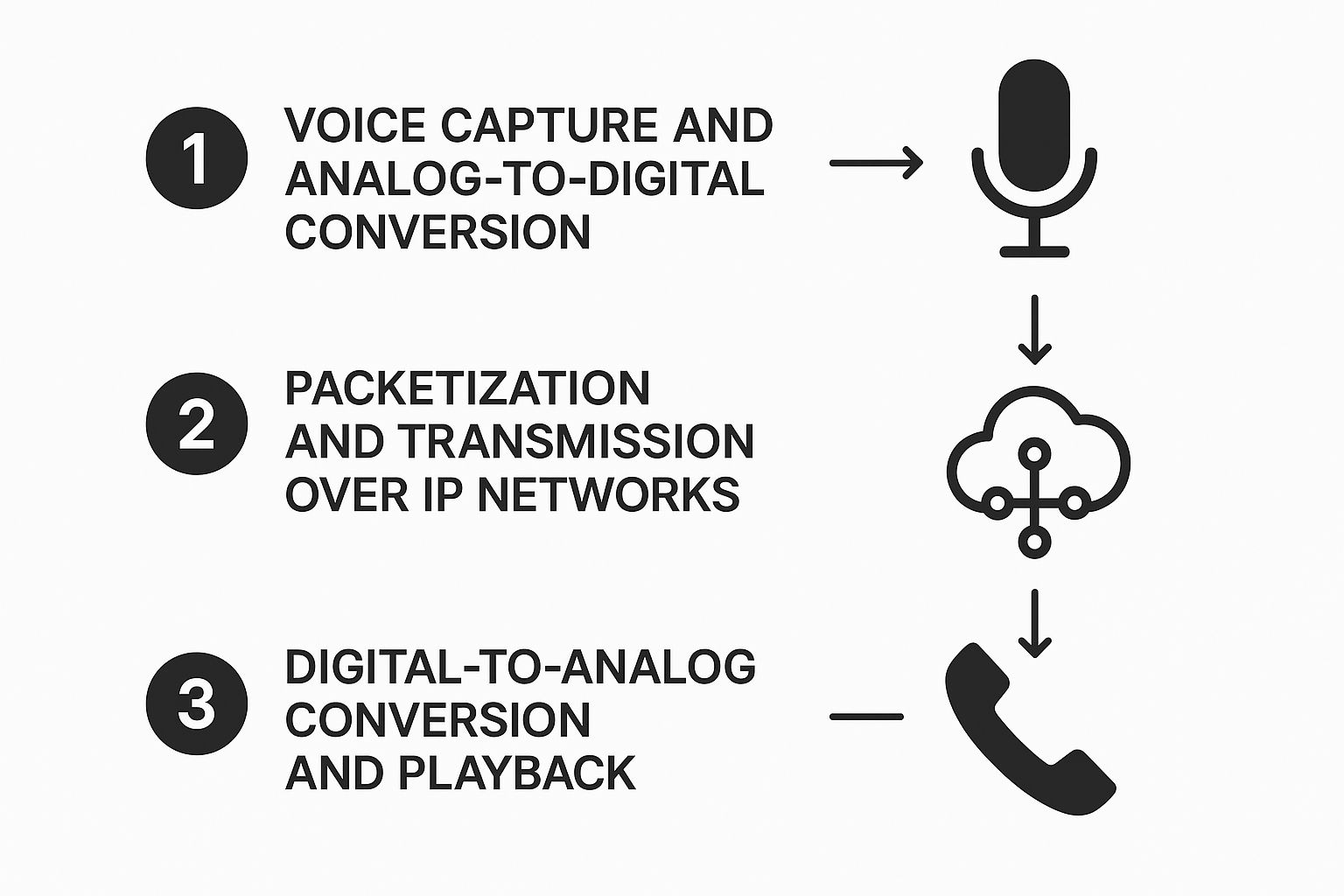Understanding Voice Over Internet Protocol in Plain English

Let's break down the technical terms. Voice over Internet Protocol (VoIP) is simply a method for making phone calls over an internet connection instead of a traditional phone line. Imagine the difference between mailing a physical letter and sending an email. Both get your message across, but VoIP uses the internet's digital pathways, which is often faster, more adaptable, and more budget-friendly.
You most likely use VoIP in your daily life without even realising it. Popular apps such as WhatsApp, Zoom, and Microsoft Teams all depend on this technology to facilitate voice and video calls. It operates by converting your voice into small digital packets of data. These packets travel across the internet and are reassembled on the other end, resulting in a clear conversation.
From Niche Tech to Global Standard
VoIP is no longer just for tech enthusiasts; it has become the standard for modern communication worldwide. Its adoption is widespread, connecting families, enabling remote work, and supporting businesses of all sizes. This expansion is particularly noticeable in regions experiencing rapid digital growth. For example, the Middle East and Africa witnessed a compound annual growth rate (CAGR) of 10.4% for VoIP services in 2023, showing its growing significance. You can learn more about this trend in this VoIP service market report.
How Does VoIP Apply to You?
Knowing what Voice over Internet Protocol is helps you appreciate the tools that influence your daily communications. This technology serves as the foundation for several key applications:
- Cost-Effective International Calls: Speak with people in other countries without the worry of expensive phone bills.
- Flexible Business Communication: Allow your team to use their business phone number from any location. Discover how a small business phone system using VoIP can improve your operations.
- Rich Communication Features: Gain access to useful tools like video conferencing, instant messaging, and call recording.
The Magic Behind VoIP: How Your Voice Travels the Internet
Have you ever stopped to think about how your voice can instantly reach someone on the other side of the world? The process behind the Voice over Internet Protocol meaning is a remarkable, high-speed journey. When you speak into your device, it doesn't just send your voice as a continuous sound wave. Instead, it captures your analogue voice and converts it into tiny digital packets. Imagine breaking a large photograph into thousands of pixels; each pixel travels separately but reassembles perfectly at the destination to recreate the full picture.
This digital conversion is just the beginning. Your voice, now transformed into a stream of data, must be prepared for its trip across the bustling information highways of the internet.
From Sound to Data Packets
The first step in this process involves components called codecs (an abbreviation of coder-decoder). These are vital software or hardware elements that compress your digitised voice data. This compression is essential because it reduces the amount of bandwidth needed, ensuring your call doesn't slow down your entire internet connection. Once compressed, the data is bundled into neat little packages, each tagged with information about its destination and its correct place in the sequence.
These packets are then sent over the internet, often taking different routes to avoid digital traffic jams, much like drivers finding the quickest way through a city during rush hour. This is managed by specific rules, or protocols, that ensure reliable delivery. For those curious about the underlying technology, protocols like the Session Initiation Protocol are fundamental. You can explore our detailed explanation of what SIP is to understand how calls are initiated and terminated.
The infographic below illustrates this three-step journey, from the sound of your voice to the listener's ear.

This visual highlights the core process: your voice is digitised, packetised for internet travel, and then perfectly reassembled on the other end.
Reassembling the Conversation
When the packets arrive at their destination, the entire process is reversed. The recipient’s device collects all the incoming data packets. It swiftly reorders them, decompresses them using the same codec, and converts the digital data back into analogue sound waves. This complete round trip—from you speaking to your words being heard—happens in a matter of milliseconds, creating the experience of a smooth, real-time conversation.
This remarkable efficiency is precisely why VoIP has become the foundation of modern communication. It powers everything from quick personal chats to global business meetings with impressive clarity and speed.
Why Everyone's Making the Switch: VoIP's Game-Changing Benefits

The widespread move from traditional phone systems isn't just a trend; it's a response to tangible benefits that redefine how we connect. While cost savings are a significant motivator—many businesses see their communication bills drop by 40-80%—the real story is about newfound freedom and a collection of powerful tools that old landlines could never provide. This technology changes the very meaning of a phone line, shifting it from a cable in the wall to a flexible, dynamic communication asset.
To understand the full financial impact, let's look at a typical cost comparison for a small business switching to VoIP. The table below outlines potential savings across different services.
VoIP Cost Savings Breakdown
Detailed analysis of potential savings when switching from traditional phone services to VoIP
| Service Type | Traditional Cost | VoIP Cost | Monthly Savings | Annual Savings |
|---|---|---|---|---|
| Line Rental (per user) | AED 150 | AED 75 | AED 75 | AED 900 |
| Local Calls | AED 0.20/min | Included | Varies | Varies |
| International Calls | AED 2.00/min | AED 0.15/min | AED 1.85/min | Significant |
| System Maintenance | AED 400 | AED 0 | AED 400 | AED 4,800 |
| Feature Add-ons | AED 50 | Included | AED 50 | AED 600 |
As the data shows, the savings accumulate quickly, especially through the reduction of international call charges and the elimination of maintenance fees. This frees up capital that can be reinvested into other areas of the business.
Unlocking Unprecedented Flexibility
Think about your office phone number no longer being physically attached to your desk. With a VoIP system, your business line travels with you wherever you find an internet connection—your home office, a local café, or a hotel on the other side of the world. This location independence is a key part of modern work, enabling remote teams to maintain a professional front and collaborate as if they were all in one place.
- Work from Anywhere: Staff can make and receive calls on their business number using a softphone app on a laptop or mobile phone.
- Global Connectivity: Connect with colleagues, clients, or family across continents without the worry of massive international call charges.
- Business Scalability: Need a new phone line for a new team member? It's done in a few clicks through an online dashboard, removing the wait and expense of physical line installations.
More Than Just a Call: Advanced Communication Features
Beyond making and taking calls, the true value of Voice over Internet Protocol for modern businesses shines through its advanced features. VoIP merges voice with other digital communication methods to form a single, unified platform. You can easily host video conferences with multiple people, receive your voicemails as audio files directly in your email inbox, and automatically route incoming calls to the right person based on their availability. These are not small tweaks; they are genuine operational upgrades that improve productivity and enrich interactions with colleagues and customers alike.
VoIP in Action: Technologies You're Already Using
The term Voice over Internet Protocol might sound technical and complex, but you’re likely using it every single day without even realising it. Have you ever made a call using Skype, WhatsApp, Zoom, or FaceTime? If so, you’ve experienced VoIP firsthand. The technology works quietly in the background, acting as the invisible foundation for a huge part of modern communication.
This technology has been a game-changer for how businesses operate, especially with the growth of remote work. VoIP allows teams scattered across different cities and even countries to connect and collaborate as if they were in the same room. Customer support centres can now have agents located all over the world, all fielding calls through one central system. A great example of this is the use of a voice AI agent to manage customer queries effectively.
Everyday and Emerging Applications
Beyond the business world, VoIP's influence is spreading into our homes and other vital sectors, making communication more accessible and integrated.
- Telehealth Services: Doctors are now able to hold video consultations with patients in remote areas, offering essential medical advice without the need for travel.
- Global Family Connections: Families living continents apart can stay connected through clear and affordable voice and video calls, making the world feel a little smaller.
- Smart Home Integration: VoIP is finding its way into smart home devices. You can now use voice commands to speak through your home security system or make calls directly from smart speakers.
The technology’s reach is also expanding into the Internet of Things (IoT), creating new pathways for people and devices to interact. This continuous development means VoIP is set to be a key component of our connected future, moving far beyond just replacing the traditional phone call.
Finding Your Perfect VoIP Match: A Practical Selection Guide

With a sea of providers out there, picking the right VoIP solution can seem like a monumental task. The trick is to tune out the flashy marketing and focus inward on what your business actually needs. Are you a small enterprise that could benefit from professional features like an auto-attendant? Or perhaps a remote worker who simply needs a reliable second phone line? Defining your main goal from the start helps you cut through the clutter.
Evaluating Key Service Types
VoIP services are not a one-size-fits-all product. They generally fall into a few distinct categories, each tailored to different types of users. Understanding these differences is the first step toward making a smart choice for your communication setup.
- Residential VoIP: This is mainly designed to replace a traditional home landline. These services provide cost-effective domestic and international calling plans but usually lack advanced business features. They are an ideal choice for families and individuals.
- Business VoIP: This category is where the voice over internet protocol meaning really comes to life for organisations. These solutions offer a powerful suite of features such as IVR (Interactive Voice Response), call recording, and integrations with CRM software. They are designed to scale with your company and maintain professional communication.
- SIP Trunking: If your business already has an on-premise PBX phone system, SIP trunking acts as a bridge. It connects your existing hardware to the internet, allowing you to gain the cost savings and flexibility of VoIP without a complete equipment overhaul.
Making an Informed Decision
Once you have identified which service category aligns with your needs, it's time to evaluate providers based on reliability, security, and customer support. Look for uptime guarantees of 99.9% or higher and take the time to read recent user reviews to get a real-world perspective. To support your decision, a comparison of leading business phone and internet providers can show you how various options compare. This methodical approach ensures the service you choose provides genuine, long-term value.
Overcoming VoIP Hurdles: Honest Solutions to Real Challenges
While the benefits of VoIP are impressive, it's fair to address the potential challenges. Understanding these hurdles from the start helps you make informed choices and get the most from your new phone system. As with any technology that runs on the internet, the main concerns usually revolve around call quality, reliable connectivity, and security.
An unstable or slow internet connection is the most frequent culprit behind issues like jitter (choppy audio) or dropped calls. This happens when the digital packets carrying your voice are delayed or lost on their journey across the web. Thankfully, this is largely a solved issue. Modern VoIP systems use advanced codecs to keep calls clear even on imperfect connections. Furthermore, prioritising voice data on your network, a process known as Quality of Service (QoS), ensures your conversations always get VIP treatment over other internet traffic.
Navigating Common Concerns
Here are practical solutions to the most common questions that arise when people explore what voice over internet protocol means for their business:
- Internet Dependency: What if my internet connection fails? Most business-grade VoIP providers include automatic call forwarding. If your office loses its connection, incoming calls are instantly rerouted to a designated mobile number or landline. This means you never miss an important call.
- Emergency Services: Can I call for help in an emergency? Today's VoIP services fully support E911 (Enhanced 911). This system automatically transmits your registered physical address to emergency responders when you dial for help. It is vital to keep this address information current, especially if your business moves to a new location.
- Security Vulnerabilities: How safe are my calls? Beyond standard cybersecurity measures, there are specific voice-related threats like vishing attacks, where attackers try to trick people over the phone. Being aware of these risks is important. Reputable VoIP providers counter these threats with powerful encryption, effectively scrambling your conversations to prevent anyone from listening in.
The Future Is Calling: Where VoIP Technology Is Heading
The technology behind Voice over Internet Protocol is doing more than just replacing old phone lines; it's actively shaping the communication experiences of tomorrow. The traditional voice over internet protocol meaning is expanding as new developments push the boundaries of what a simple call can do. The future of communication is interactive, intelligent, and more connected than ever.
Intelligent and Immersive Communication
Artificial intelligence (AI) is at the heart of this evolution. It's already being used to automatically enhance call quality, offer real-time language translation, and even analyse sentiment during customer service calls. For businesses, this translates into deeper insights and more meaningful interactions. At the same time, the global rollout of 5G networks is providing the high-speed, low-latency connection needed for these advanced features to work seamlessly.
This powerful combination of AI and strong connectivity sets the stage for genuinely immersive experiences:
- Augmented Reality (AR) Meetings: Picture having a conference call with holographic versions of your colleagues, effectively erasing the line between being physically present and virtually connected.
- Proactive Assistance: AI could soon predict the ideal times to reach out to team members across different time zones, optimising collaboration without the usual scheduling hassle.
- Hyper-Personalised Interactions: Imagine calls that automatically adjust to a user's situation, providing relevant information or tools without needing to be asked.
This forward-thinking perspective shows that VoIP is the essential foundation for the next generation of human interaction. To see how businesses are already putting these technologies to use, you can learn more about Voice over IP in Dubai and its expanding influence in the region.
Ready to prepare your business communications for what's next? Find out how Cloud Move can provide a customised, scalable, and secure telephony solution for your organisation. Book a free demo today and step into the future of connection.




